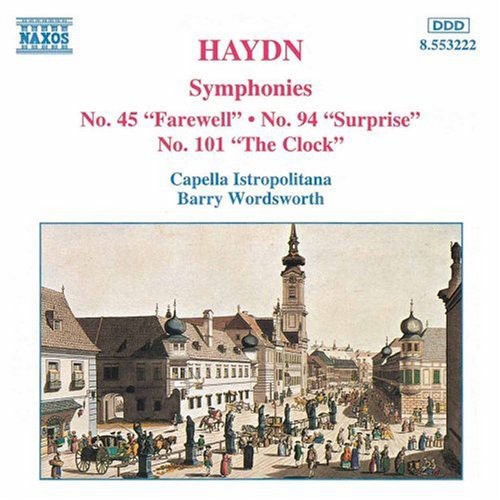Show results for
Deals
- 4K Ultra HD Sale
- Action Sale
- Alternative Rock Sale
- Anime sale
- Award Winners Sale
- Bear Family Sale
- Blu ray Sale
- Blues on Sale
- British Sale
- Classical Music Sale
- Comedy Music Sale
- Comedy Sale
- Country Sale
- Criterion Sale
- Cult Films sale
- Documentaries Sale
- Drama Sale
- Electronic Music sale
- Horror Sci fi Sale
- Kids and Family Sale
- Metal Sale
- Music Video Sale
- Musicals on Sale
- Mystery Sale
- Naxos Label Sale
- Page to Screen Sale
- Paramount Sale
- Rap and Hip Hop Sale
- Reggae Sale
- Rock
- Rock and Pop Sale
- Rock Legends
- Soul Music Sale
- TV Sale
- Vinyl on Sale
- War Films and Westerns on Sale

Symphonies 45, 94 & 101
- Format: CD
- Release Date: 5/23/1995

Symphonies 45, 94 & 101
- Format: CD
- Release Date: 5/23/1995
- Composers: Franz Joseph Haydn
- Conductors: Barry Wordsworth
- Label: Naxos
- UPC: 730099422222
- Item #: NAX942222
- Genre: Classical
- Release Date: 5/23/1995

Product Notes
Haydn's Farewell Symphony was written in 1772, occasioned by the prolonged stay of Prince Nikolaus Esterházy at his Hungarian palace. Some of the musicians had been compelled to leave their wives behind in Eisenstadt when the Prince took up his summer residence. The Symphony, in the final Adagio of which the musicians leave one by one, was intended as a delicate hint that the time had come to return to Eisenstadt, although some contemporary sources suggest that the subject of complaint was the possible reduction of the musical establishment. The Symphony, in the key of F sharp minor, is scored for the usual Esterháza forces of pairs of oboes and horns, bassoon and strings. The first movement opens with the principal theme, descending arpeggios played by the first violins against sustained wind chords and the urgent syncopation of the second violins. Sonata form is treated with considerable freedom, the second subject making it's D major appearance in the development and the following recapitulation inviting an unusual further development of the principal theme. The A major second movement allows muted violins to announce the main theme, the wind having very little to add during the course of the movement. An F sharp major Minuet follows, with a Trio that allows the French horns momentary prominence. This leads to a finale that modulates to introduce the unexpected slow conclusion, in which player after player leaves the platform, until only two muted violins are left. Symphony No.101 belongs to the group of six symphonies written for Haydn's second visit to London in 1794. It was played there at a concert on 3rd March, followed by operatic songs, a performance by Viotti of a violin concerto and by Fiorillo of a Chaconne. Again, as with most of the London symphonies, there is a slow introduction, this time in D minor, an eerie preface to a bright D major movement from which the symphony derives it's nickname, The Clock, it's source the accompanying figure with which the movement opens. The Minuet returns from G major to the key of D major, it's Trio providing a lop-sided clock accompaniment to the initial flute melody. The symphony ends with a finale in which the second subject is a clear variant of the first. There is a D minor section, replaced by the major key to bring the work to a dramatic conclusion.

